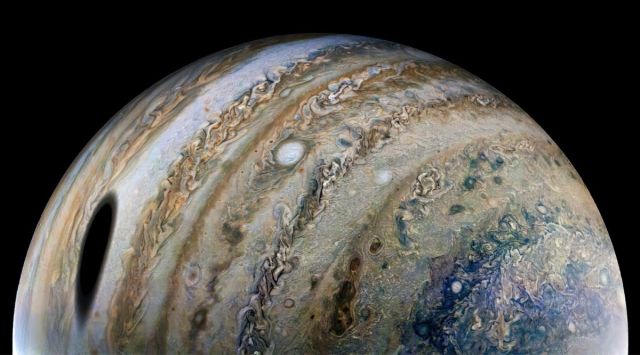එහි මතුපිට අලංකාර කරන විචිත්රවත් ඉරි සඳහා ප්රසිද්ධ බ්රහස්පති ග්රහයා දිගු කලක් තිස්සේ එහි නිරන්තරයෙන් වෙනස් වන වර්ණයන්ගෙන් විද්යාඥයන් ආකර්ෂණය කර ඇත. දැන්, පෙරළිකාර සොයාගැනීමක් මෙම ගතික ලක්ෂණ ඇති කරන ප්රහේලිකා සංසිද්ධියට ආලෝකයක් ලබා දී ඇත.
බ්රහස්පතිගේ වායුගෝලයේ ඇති සිත් ඇදගන්නා ඉරි රසායනික සංයුතියේ සහ උෂ්ණත්වයේ විචලනයන්ගේ ප්රතිඵලයකි. "කලාප" සහ "පටි" ලෙසින් හඳුන්වනු ලබන ආලෝක සහ අඳුරු පටි පිළිවෙලින් වායුව ඉහළ යන හෝ බැස යන ප්රදේශ නිරූපණය කරයි.
මෙම වායුගෝලීය වායු ප්රවාහයන් බ්රහස්පති ග්රහයාගේ වේගවත් භ්රමණය සමඟ සංකීර්ණ ලෙස බද්ධ වී ඇත—එය පැය 10කින් දිනක් සම්පූර්ණ කරයි—එය ප්රබල සුළං උත්පාදනය කරයි. මෙම සුළං, අනෙක් අතට, කැළඹිලි සහ සිත් ඇදගන්නාසුළු සුළි ඇති කරයි, මහා රතු ලප වැනි, සියවස් ගණනාවක් පුරා පවතින දැවැන්ත කුණාටුවක්.
නමුත් මෙම විස්මය දනවන ඉරි වර්ණයෙන් සංක්රමණය වීමට හේතුව කුමක්ද? Nature Astronomy හි ප්රකාශයට පත් කරන ලද නවතම අධ්යයනයක් පිළිතුරක් සපයයි, වායුව සහ හිරු එළිය අතර අන්තර් ක්රියාකාරිත්වය ඉස්මතු කරයි. 2016 වසරේ සිට බ්රහස්පති ග්රහයා වටා පරිභ්රමණය වන නාසා ආයතනයේ ජූනෝ මෙහෙයුමේ දත්ත උපයෝගී කරගනිමින් විද්යාඥයන් මෙම කලාප සහ පටිවල රසායනික සංයුතිය ඉතා සියුම් ලෙස විශ්ලේෂණය කළහ.
ඔවුන්ගේ සොයාගැනීම්වලින් හෙළි වූයේ කලාපවල වැඩි ඇමෝනියා සහ ජල වාෂ්ප සාන්ද්රණයක් අඩංගු වන අතර ඒවා වැඩි දියුණු කළ පරාවර්තකතාවයක් සහ සැහැල්ලු පැහැයක් ලබා දෙන බවයි. ඊට වෙනස්ව, පටිවල සල්ෆර් සහ පොස්පරස් සංයෝග වැඩි ප්රමාණයක් අඩංගු වන අතර, වැඩි හිරු එළිය අවශෝෂණය කර අඳුරු පටි ලෙස ප්රකාශ වේ.
කෙසේ වෙතත්, සූර්යාලෝකය මෙම සංයෝග සමඟ අන්තර්ක්රියා කරන විට, එය හයිඩ්රජන් සල්ෆයිඩ් සහ පොස්පයින් වැනි කුඩා අණු බවට වියෝජනය කරයි. මෙම සැහැල්ලු අණු ඉහළ උන්නතාංශවලට නැඟී, සූර්යයාගේ පාරජම්බුල කිරණවලට මුහුණ දෙයි. මෙම විකිරණයට නිරාවරණය වීම අඳුරු සිට දීප්තිමත් දක්වා පරිවර්තනයක් ඇති කරයි, පහළ වායු ස්ථර සමඟ කැපී පෙනෙන වෙනසක් නිර්මාණය කරයි.
තවද, පර්යේෂකයන් නිරීක්ෂණය කළේ මෙම වර්ණ වෙනස් කිරීමේ ක්රියාවලිය විශේෂයෙන් සමකයට ආසන්නව ප්රකාශ වන අතර එහිදී සූර්ය කිරණ වඩාත් ශක්තිමත් වන අතර සුළං වේගවත් වේ. බ්රහස්පති ග්රහයා මත ඇති ඇතැම් ඉරි ඒවායේ පිහිටීම සහ පවතින සමය මත කාලානුරූපව මැකී යාම හෝ දීප්තිමත් වීම පෙනෙන්නේ මන්දැයි මෙයින් පැහැදිලි වේ.
මෙම පෙරළිකාර අධ්යයනය බ්රහස්පතිගේ සංකීර්ණ වායුගෝලීය ගතිකත්වය පිළිබඳ අපගේ අවබෝධය ගැඹුරු කරනවා පමණක් නොව ග්රහලෝකයේ පෙනුම හැඩගැස්වීමේදී සූර්යාලෝකය විසින් ඉටු කරන ලද ප්රධාන කාර්යභාරය ද හෙළි කරයි. එපමනක් නොව, සෙනසුරු, යුරේනස් සහ නෙප්චූන් වැනි අනෙකුත් වායු යෝධයන්ගේ වර්ණවලට බලපාන සමාන ක්රියාවලීන්හි විභව පැවැත්ම පිළිබඳව එය වටිනා අවබෝධයක් ලබා දෙයි.
බ්රහස්පතිගේ නිරන්තරයෙන් වෙනස් වන ඉරි හෙළිදරව් කිරීම අපගේ ආකාශ අසල්වැසියන්ගේ අභිරහස් හෙළිදරව් කිරීමේ වැදගත් සන්ධිස්ථානයක් සනිටුහන් කරයි, අපගේ සෞරග්රහ මණ්ඩලය තුළ ඇති විශාල අරුමපුදුම දේ පිළිබඳ වඩාත් පුළුල් චිත්රයක් පින්තාරු කරයි.
Jupiter, renowned for its vibrant stripes adorning its surface, has long captivated scientists with its ever-shifting colors. Now, a groundbreaking discovery has shed light on the enigmatic phenomenon that gives rise to these dynamic features.
The mesmerizing stripes on Jupiter's atmosphere are a consequence of variations in chemical composition and temperature. Referred to as "zones" and "belts," the light and dark bands respectively depict regions where gas is ascending or descending.
These atmospheric gas flows are intricately intertwined with Jupiter's rapid rotation—completing a day in merely 10 hours—which generates powerful winds reaching staggering speeds of up to 600 km/h. These winds, in turn, give rise to turbulence and mesmerizing vortices like the iconic Great Red Spot, a colossal storm persisting for centuries.
But what causes these awe-inspiring stripes to transition in color? A recent study published in Nature Astronomy provides the answer, highlighting the interplay between gas and sunlight. Leveraging data from NASA's Juno mission, which has been orbiting Jupiter since 2016, scientists meticulously analyzed the chemical composition of these zones and belts.
Their findings unveiled that the zones contain higher concentrations of ammonia and water vapor, endowing them with enhanced reflectivity and a lighter hue. In contrast, the belts harbor greater amounts of sulfur and phosphorus compounds, absorbing more sunlight and manifesting as darker bands.
However, when sunlight interacts with these compounds, it triggers their decomposition into smaller molecules such as hydrogen sulfide and phosphine. These lightweight molecules ascend to higher altitudes, where they encounter the sun's ultraviolet radiation. The exposure to this radiation causes a transformation from dark to bright, creating a striking contrast with the lower gas layers.
Furthermore, the researchers observed that this color-altering process is particularly pronounced near the equator, where solar radiation is stronger, and the winds are swifter. This elucidates why certain stripes on Jupiter appear to fade or brighten periodically, contingent upon their location and the prevailing season.
This groundbreaking study not only deepens our understanding of Jupiter's intricate atmospheric dynamics but also unveils the pivotal role played by sunlight in shaping the planet's appearance. Moreover, it offers valuable insights into the potential existence of similar processes affecting the colors of other gas giants like Saturn, Uranus, and Neptune.
The revelation of Jupiter's ever-changing stripes marks a significant milestone in unraveling the mysteries of our celestial neighbors, painting a more comprehensive picture of the vast wonders that lie within our solar system.





